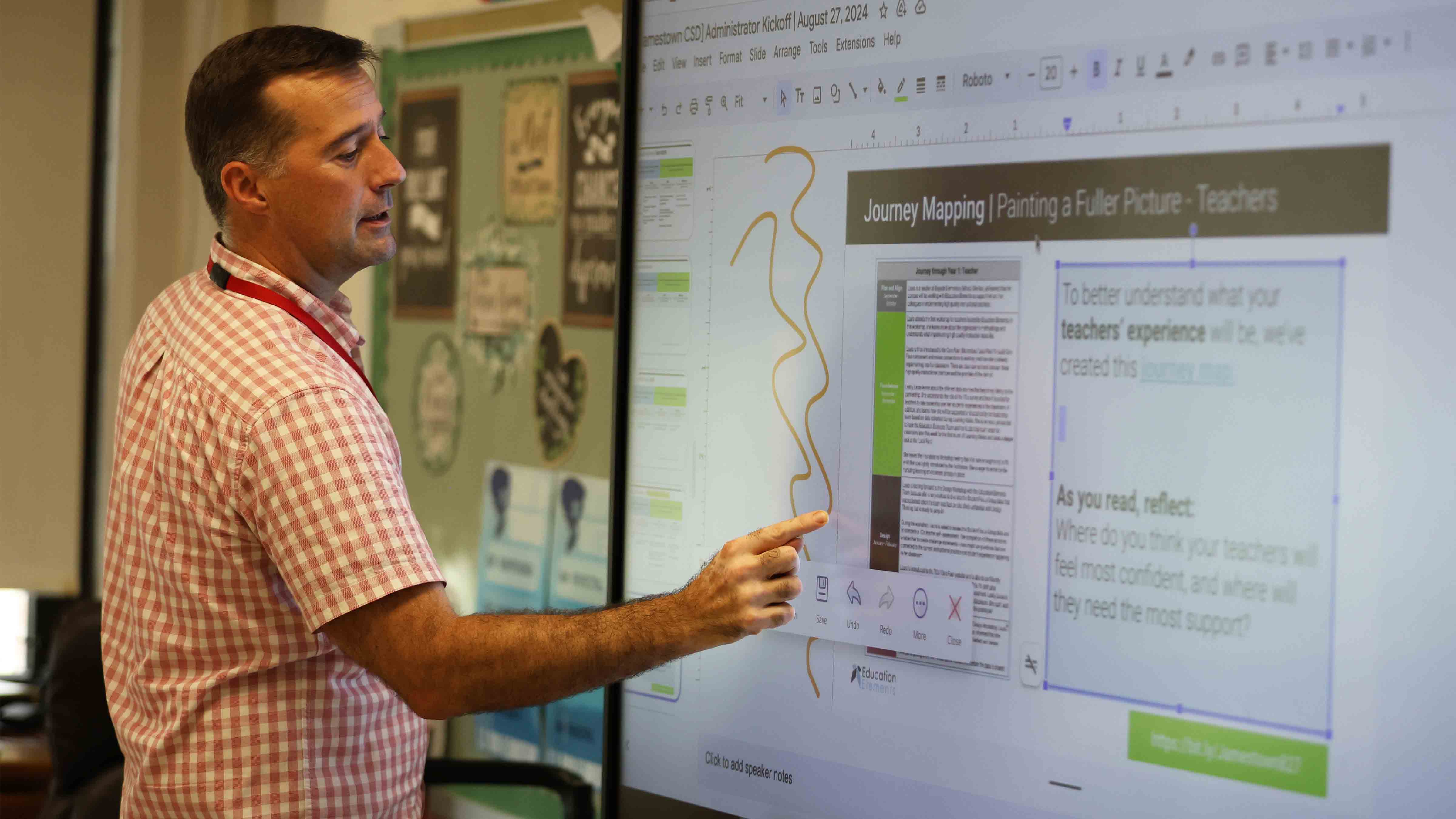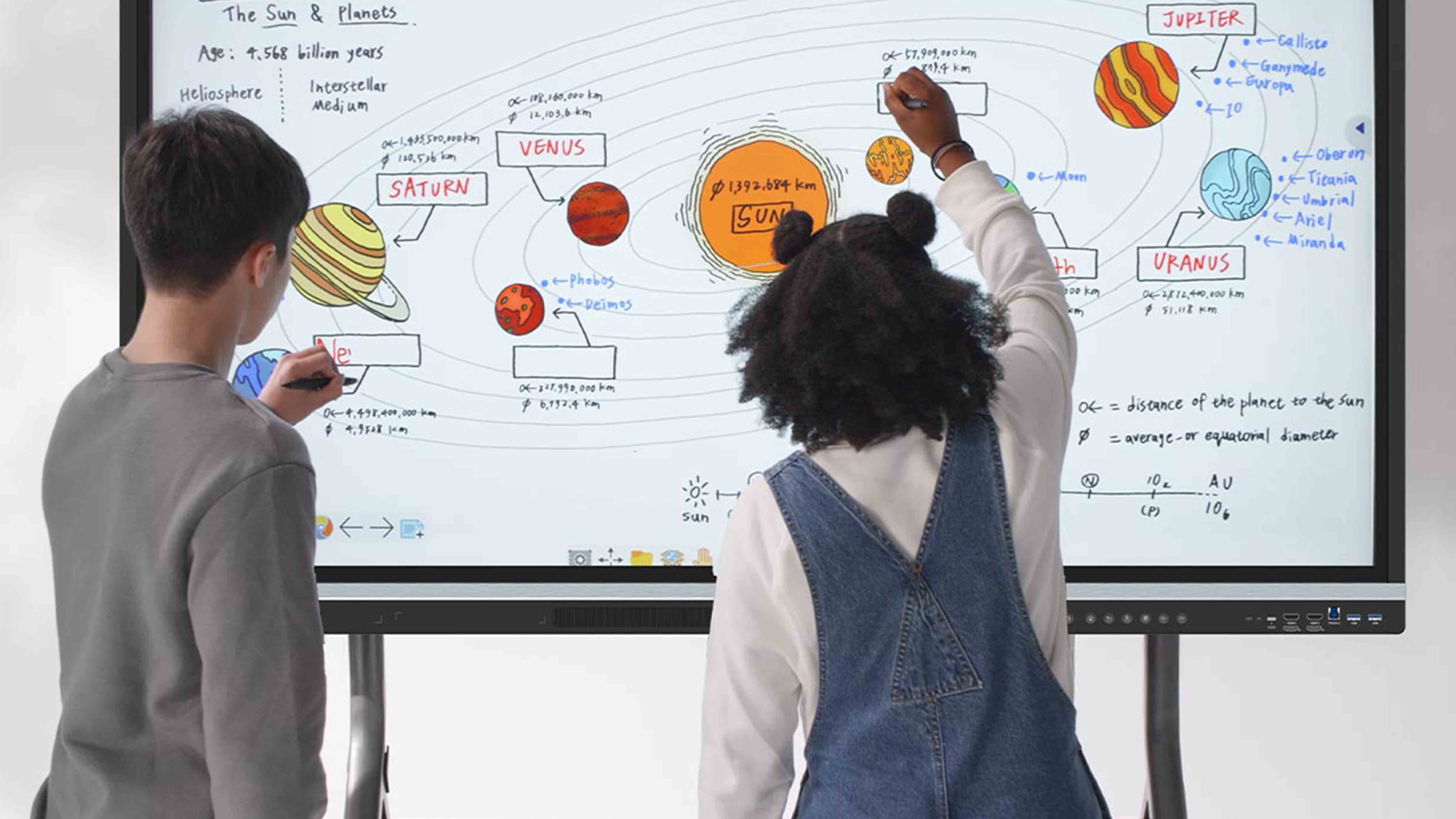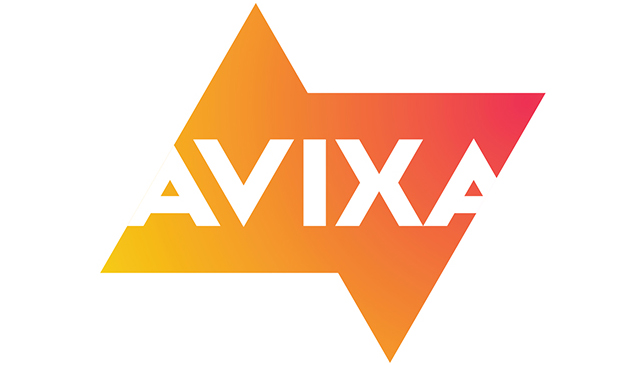Why Smartboards Are Smart Thinking
AI and seamless connectivity are among the trends driving development.


In 1991, SMART Technologies introduced interactive video displays commonly known as "smartboards," even though the company refers to them as "SMART Boards." That’s the curse of being a leader in your field: Like Kleenex, SMART Technologies pioneered their market segment so well that their product name became synonymous with a commodity.
Fast forward to 2025: Today, a wide range of companies have joined SMART Technologies in producing smartboards, which are in great demand in business, educational, and government settings. Here are the trends that are driving the industry, as told to SCN by its top players.
Better Engagement
Talk to smartboard manufacturers and they’ll provide you with a laundry list of trends that are driving smartboard design and development. Case in point: “A few trends that I’ve noticed are security, ease-of-use, integration with other AV equipment, and device management features,” said Sean Liu, senior business line manager with ViewSonic Corporation. “Of these, data security is the most important. This is followed by ease-of-use and the integration of conferencing software such as Teams, Zoom, and Google Meet, since most collaboration today involves hybrid work.”
According to Sam Malik, MAXHUB’s VP of sales and marketing, the biggest trend driving smartboards these days is the ability to support "one-touch" meetings. “People want to walk into the room and easily start a meeting without delay or having any technical knowledge of how to operate the devices,” he explained.
As for SMART Technologies’ take on trends? “People are looking for working and learning environments to be more engaging and connected, no matter where they are,” said Nicholas Svensson, president and CEO. “This is what continues to drive our focus at SMART: to create simple, walk-up-and-use experiences, which helps our users engage instantly and focus more on collaboration than technology setup.”
Over at Avocor, its eye is on AI. “The rise of AI-powered features, cloud-based collaboration tools, and 4K resolution displays are accelerating the adoption of smartboards,” said Dana Corey, Avocor’s GM/SVP of global sales. “At Avocor, we see growing demand for solutions that reduce video fatigue and support real-time annotation and remote access, key to enabling inclusive, productive meetings and lessons."
“One of the biggest trends—next to AI, of course—in the workplace is a strong push for flexibility,” said Nathan Coutinho, global head of strategic partner relations and market insights, Logitech for Business. “Whether employees are working from home or brainstorming around a conference table, smartboards are increasingly becoming an important part of this mix, not only to bridge the gap between on-site and remote participants, but to adapt to virtually any space they choose to work, whether it’s a huddle room or open space."
A daily selection of the top stories for AV integrators, resellers and consultants. Sign up below.
In the education market, today’s smartboard trends are "driven by the need for increased student engagement, simplified user experiences, and future-ready learning environments,” said Victoria Sanville, director of education with LG Electronics USA. “According to a report by the Brookings Institution, technology that facilitates differentiated instruction and increases learner engagement can accelerate learning outcomes. This aligns with the growing role of smartboards as interactive, multimedia-rich platforms that connect classroom content with students’ highly digital lives.”
Finally, there’s the "bigger is better" trend. "There is a growing demand for larger displays," confirmed Dr. Micah Shippee, Samsung’s director of education solutions and channel sales. “Whereas 65-inch screens were commonplace, 75-inch boards have now become the new standard, with an increased interest in 86-inch models. This trend is driven by the need for better visibility for all learners in the classroom."
Shippee said educators also want interactive displays that can integrate easily with their existing devices. Plus, connectivity—both wired like USB-C for touch, power, and display wireless casting from laptops or mobile devices—is a major factor.
"Simplified, seamless connections help teachers use interactive displays more effectively without disrupting their established workflows. As well, there's increasing interest in bidirectional casting, which sends content from the interactive display to individual student devices. This gives every learner a ‘front-row seat,’ improving accessibility and engagement, especially in larger or more distributed classrooms.”
Special Attention
Clearly, smartboards are evolving from cutting-edge novelties to must-have necessities. Small wonder: The technology is just too useful—and fits so well with other networked AV devices—that smartboards just make sense in so many AV installations. However, not all smartboards are made equal.

For example, Liu emphasized the importance of built-in microphones and speakers, because they reduce the amount of setup needed to start videoconferencing from the smartboard. “The all-in-one concept has become very popular and in demand,” Malik added. “Displays with fully integrated microphones, multiple cameras with AI tracking capability, and built-in speakers feed that one-touch meeting concept.”
Clients also like when their smartboards can serve as giant videoconferencing systems. As a result, certification with platforms like Microsoft Teams and Zoom is "critical in the corporate world, where IT departments prioritize compatibility, security, and support,” said Corey.
"Whether a smartboard is being used for corporate ideating, presenting evidence in a courtroom trial, or bringing lessons to life in a classroom setting, there are universal features that are industry-agnostic,” Coutinho said. “For instance, smartboards should be easy to set up and use, support multi-touch capability, come with a stylus, and be built for deployment in a variety of settings.”
Speaking of smartboard writing instruments, Svensson said most interactive displays today, including SMART Boards, come with dedicated writing instruments along with built-in storage trays. "But what sets SMART apart is how intuitive our tools are,” he noted. “What’s important for buyers to consider is the ease of use of these tools. Does the user have to select a tool before using the pen? Can two more pens be used at one, along with a finger to write or palm to erase? After all, interactive displays should be as simple to use as old non-digital displays."
Finally, smartboards should be easy to use. “It’s not enough for a display to offer high-quality visuals or advanced features,” Sanville offered. “If the interface is too complicated, the technology simply won’t be used. That’s why standardizing interactive display systems across classrooms and schools is more important than ever. When every display operates the same way, teachers don’t waste instructional time learning new systems, and students can focus on content rather than logistics."
Getting Smarter
Clearly, there are many trends driving today's smartboard market. As for the innovations that will drive this technology forward? “One of the most exciting developments is the integration of AI-powered features,” said Svensson. “We’re incorporating tools like live transcription, adaptive learning platforms, and intelligent camera tracking into our displays, making interactive displays more connected, personalized, and effective for modern classrooms and workplaces than ever before.”
“The latest innovations include AI-enhanced collaboration tools,” Corey agreed. “They also include edge-to-edge glass designs and modular systems that adapt to different room sizes. There’s also a push toward sustainability—energy-efficient displays, recyclable materials, and longer product lifecycles.”
[4 on the Floor: Lessons from InfoComm 2025]
"What’s new in the interactive display world is a clear shift toward intentional, user-centered design that emphasizes simplicity, flexibility and ease of communication,” said Shippee. “Modern interactive displays are being developed not as complex ecosystems requiring proprietary or subscription-based software, but as tools that amplify existing communication practices.”
The bottom line: As important as smartboards are right now, they will be even more capable tomorrow. For AV designers, integrators, and installers, smartboards remain a smart AV equipment consideration.
James Careless is an award-winning freelance journalist with extensive experience in audio-visual equipment, AV system design, and AV integration. His credits include numerous articles for Systems Contractor News, AV Technology, Radio World, and TV Tech, among others. Careless comes from a broadcasting background, with credits at CBC Radio, NPR, and NBC News. He currently co-produces/co-hosts the CDR Radio podcast, which covers the Canadian defense industry. Careless is a two-time winner of the PBI Media Award for Excellence.

